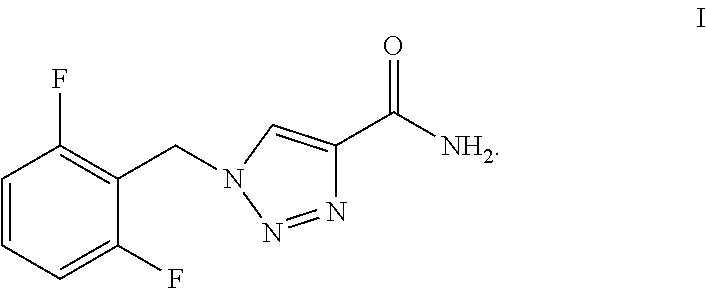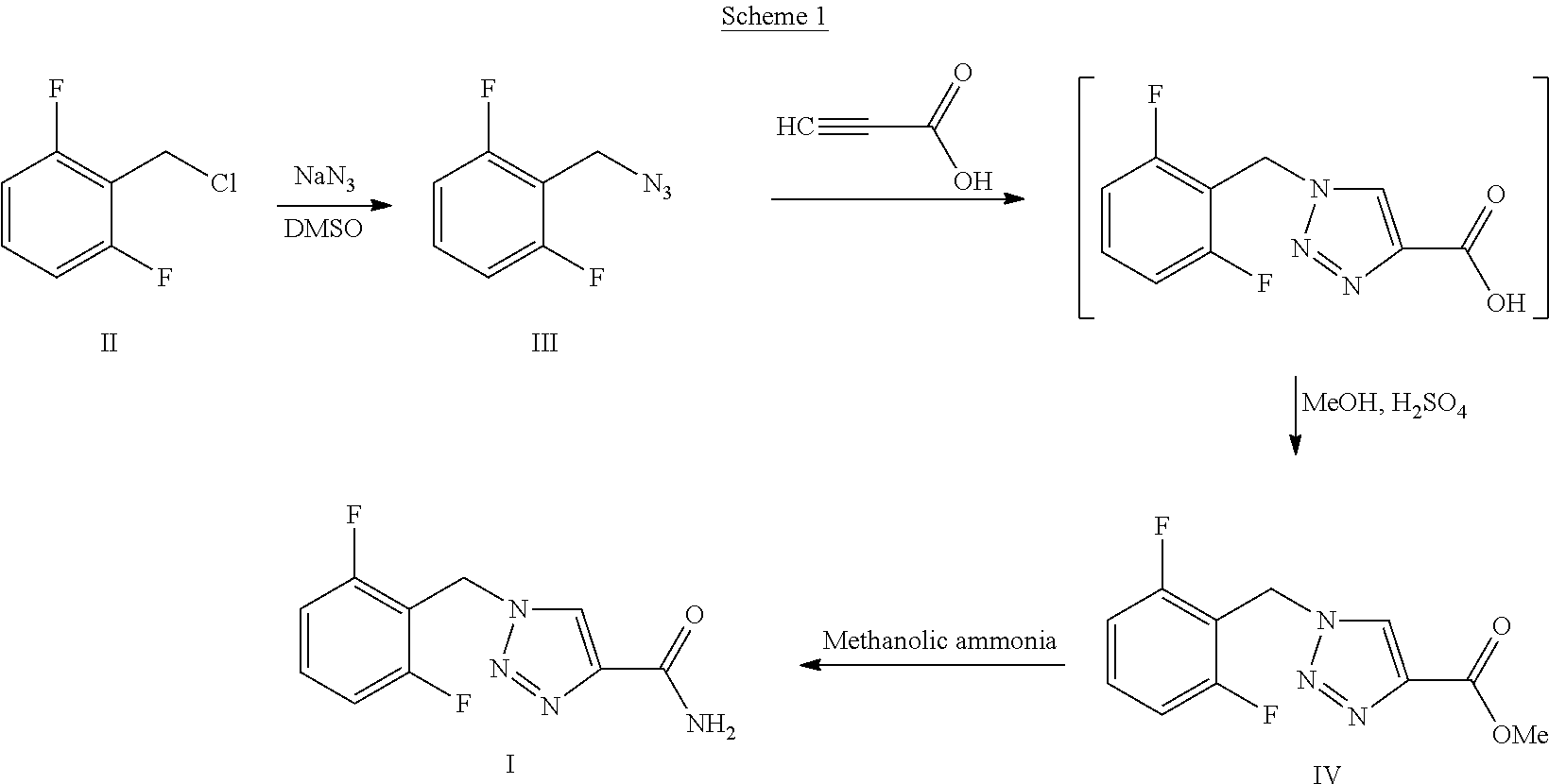Process for the Preparation of Rufinamide
a technology of rufinamide and rufinamide, which is applied in the field of improved preparation of rufinamide, can solve the problems of low yield
- Summary
- Abstract
- Description
- Claims
- Application Information
AI Technical Summary
Benefits of technology
Problems solved by technology
Method used
Image
Examples
example 1
[0046]One-pot Preparation of 1-[(2,6-Difluorophenyl)methyl]-1H-1,2,3-triazole-4-carboxamide (Rufinamide):
[0047]In a 250 ml round bottom flask, 2,6-difluorobenzylbromide (0.024 mol, 5 g), sodium azide (0.026 mol, 1.72 g) and water (50 ml) were added. The reaction mixture was heated to 70° C. to 75° C. for 30 hours and formation of the azide intermediate was monitored by thin layer chromatography (TLC). After the completion of reaction, the reaction contents were cooled to room temperature and then to this methyl propiolate (0.024 mol, 2.1 ml) was added dropwise, maintaining the contents at room temperature. On complete addition, the mixture was again heated at 60° C. to 65° C. for 4 to 5 hours. After the reaction was completed, the contents were cooled to room temperature and to this 25% aqueous ammonia (40 ml) solution was added dropwise. The reaction contents were heated to 70° C. to 75° C. for 4 to 5 hours and then gradually cooled to room temperature. The solid obtained was filte...
example 2
[0048]Multistep Preparation of 1-[(2,6-Difluorophenyl)methyl]-1H-1,2,3-triazole-4-carboxamide (Rufinamide):
Step A—Preparation of 2-(azidomethyl)-1,3-difluorobenzene:
[0049]To a 250 ml round bottom flask, 2,6-difluorobenzylbromide (0.024 mol, 5 g), sodium azide (0.026 mol, 1.72 g) and water (50 ml) were charged. The reaction mixture was heated to 70° C. to 75° C. for 30 hours and formation of azide intermediate (99.4%) was monitored by gas chromatography. After completion of the reaction, the contents were cooled to room temperature. The layers of the reaction mixture were separated to obtain an upper water layer and a lower azide intermediate layer. The lower layer was then concentrated and dried under vacuum to obtain 3.8 g of the product.
Step B—Preparation of methyl 1-(2,6-difluorobenzyl)-1H-1,2,3-triazole-4-carboxylic Acid:
[0050]In a 250 ml round bottom flask, 2-(azidomethyl)-1,3-difluorobenzene (0.0207 mol, 3.0 g) as obtained from step A and water (50 ml) were charged. To this mi...
PUM
| Property | Measurement | Unit |
|---|---|---|
| temperature | aaaaa | aaaaa |
| temperature | aaaaa | aaaaa |
| reaction time | aaaaa | aaaaa |
Abstract
Description
Claims
Application Information
 Login to View More
Login to View More - R&D
- Intellectual Property
- Life Sciences
- Materials
- Tech Scout
- Unparalleled Data Quality
- Higher Quality Content
- 60% Fewer Hallucinations
Browse by: Latest US Patents, China's latest patents, Technical Efficacy Thesaurus, Application Domain, Technology Topic, Popular Technical Reports.
© 2025 PatSnap. All rights reserved.Legal|Privacy policy|Modern Slavery Act Transparency Statement|Sitemap|About US| Contact US: help@patsnap.com



